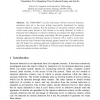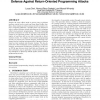19 search results - page 3 / 4 » On evolving buffer overflow attacks using genetic programmin... |
ICNC
2005
Springer
13 years 10 months ago
2005
Springer
The DARPA/MIT Lincoln Laboratory off-line intrusion detection evaluation data set is the most widely used public benchmark for testing intrusion detection systems. But the presence...
CCS
2009
ACM
13 years 9 months ago
2009
ACM
Despite the many efforts made in recent years to mitigate runtime attacks such as stack and heap based buffer overflows, these attacks are still a common security concern in today...
OSDI
2006
ACM
14 years 5 months ago
2006
ACM
Software attacks often subvert the intended data-flow in a vulnerable program. For example, attackers exploit buffer overflows and format string vulnerabilities to write data to u...
CCS
2008
ACM
13 years 7 months ago
2008
ACM
Harvard architecture CPU design is common in the embedded world. Examples of Harvard-based architecture devices are the Mica family of wireless sensors. Mica motes have limited me...
IJNSEC
2008
13 years 5 months ago
2008
One approach to protect distributed systems implemented with mobile code is through program obfuscation. Disguising program intent is a form of information hiding that facilitates...


